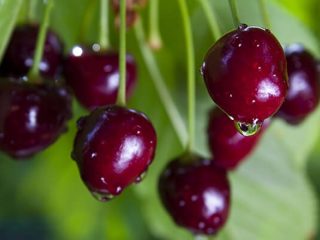Content
Mayskaya cherry grows mainly in the south of Russia, in the republics of Transcaucasia, in Ukraine and Moldova. In spring it is one of the first to bloom. At the end of May, gardeners have the opportunity to enjoy the first tender berries with a sweet and sour taste.
History of selection
It is known that the wild plant of the species Cerasus avium is 2 thousand years old. It was called bird cherry because birds happily feast on the fruits without allowing them to ripen. Subsequently, some gardeners, in order not to be left completely without a harvest, pick the berries before they have time to become full of sweetness.
Thanks to migratory sweet tooths, cherry pits from Greece and the Caucasus were brought to central Europe and took root there.
The main breeding work was aimed at obtaining frost-resistant varieties. They crossed with cherries, with other varieties of cherries obtained earlier. Gardeners have noticed that a tree growing alone is not very fertile. To obtain good harvests, 2-3 seedlings of different varieties are planted.This is how unplanned selection occurred. Systematic breeding work with cherries began to be carried out in the 20th century. In Russia, their founder can be called the famous breeder I.V. Michurina.
Early varieties were obtained successfully. Frost resistance of the southern berry remains limited. In central Russia, cherries are grown due to global warming rather than successful selection.
Description of culture
When May cherries ripen, the leaf buds on most trees are just beginning to swell. Considering the fact that breeders have bred 2 varieties of May cherries, the description of the varieties will briefly describe their characteristics:
- May red, characterized by a sour taste;
- May black cherries have a dark burgundy color and a sweet taste.
The trees tend to grow in height, grow up to 10 meters, and have a peak-shaped crown. The spreading crown becomes a result of proper pruning. The leaves are larger and longer than cherry leaves, although the fruits are somewhat similar to each other.
Description of May red and black cherries
With excessive moisture, the fruit tastes watery and has low sugar content. Ripe berries are dark, but the flesh of red cherries is red, with light veins. The juice also turns out red. The relatively small stone easily falls away from the pulp.
Ripe berries of May black cherries have a dark, almost black color. The berries are larger than early red ones, round and slightly flattened. The pulp is dense, with a characteristic aroma and sweet taste.
Characteristics
Drought resistance, winter hardiness
May cherries do not tolerate frost well. The tree, of course, will not die, but it will not produce a harvest. It also does not tolerate excess moisture. During the rains, the berries on the trees crack and rot.It will tolerate drought much easier. True, if there is a lack of moisture, the fruits will be smaller and drier.
Pollination, flowering period and ripening time
The flowers of the red May berry are snow-white; in the black May berry variety they have a soft pink tint. This plant is cross pollinated.
In the southern regions of the Russian Federation, the variety lives up to its name - the first edible fruits appear at the end of May. In central Russia, the fruits ripen in the first half of June.
Productivity, fruiting
May cherries begin to bear fruit at the age of 4 years. Its berries are small - 2-4 grams. One tree produces an average of up to 40 kg of fruit.
Resistance to diseases and pests
Judging by the description of the early May cherry variety, it still remains a capricious berry that requires preventive measures. A fruit plant is attacked at different times by:
- Aphids attacking leaves and young shoots;
- Elephant, which settles in developing fruits;
- A winter moth eating a pistil with an ovary.
Advantages and disadvantages
Red T-shirt is characterized by high yield, but is not stored for a long time. The Mayskaya cherry variety is also of little use for canning and transportation. Its advantage lies in the fact that it is one of the first fresh fruits, ready to compensate for the deficiency of vitamins and microelements. All other fruits - apricots, plums, especially peaches, apples will appear in a month and a half. Although this berry may not seem tasty enough or watery, the human body, yearning for vitamins during the winter, is grateful to it for its mere existence.
Descriptions of May cherries and reviews of their cultivation in different regions of the country are contradictory. This is due to two reasons:
- In some regions, the Mike cherry variety manifests itself ambiguously. This is explained by the climate, soil characteristics;
- Gardeners do not always have the correct understanding of varieties, giving out one variety of fruit after another.
Conclusion
The Maiskaya cherry continues to develop through the efforts of breeders and gardeners. The taste characteristics of fruits, viability, and productivity are improved. The geography of its distribution is expanding.
Reviews










